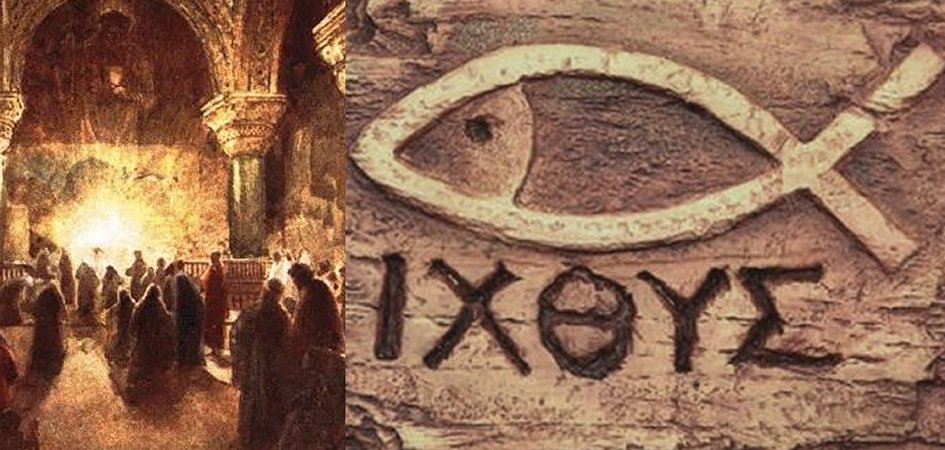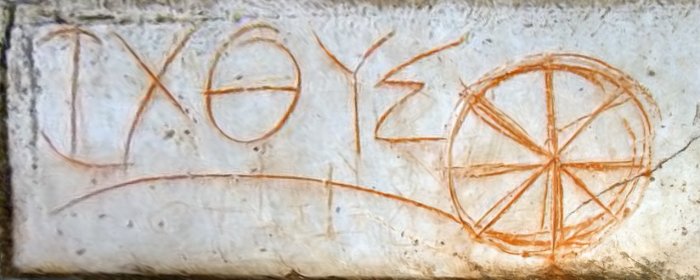Mysterious Ichthys – Ancient Secret Christian Symbol With A Deep Meaning
Ellen Lloyd - AncientPages.com - Early Christians used many secret symbols and one of them was known as the Ichthys. Named for the Koine Greek term for fish, this ancient symbol consists of two intersecting arcs, the ends of the right side extending beyond the meeting point. The symbol was simply made in the image of a fish.
So, why would early Christians use secret symbols in the first place and why was one of them resembling a fish?
Secret Symbols Protected Persecuted Christians
The answer to the first part of the question is not difficult to answer, but the true meaning of the fish symbols is still a question of debate.
The first 300 years after Jesus’ death Christians were persecuted in the Roman Empire. To avoid being killed for their faith, early Christians used secret codes that showed the way to a Church and many secret symbols protected believers of Christianity.
See also:
Ancient Symbol Fleur-de-lis: It’s Meaning And History Explained
The Sistine Chapel Cypher – Secret Messages In The Art Of Michelangelo
10 Types Of Ancient Crosses In Different Cultures Explained
Ancient Symbol Hamsa: It’s Meaning And History Explained
For example, if a Christian met a stranger, he could draw an arc on the ground. If the stranger completed the image with another arc so it formed a fish, they would both know they were Christians. This was a clever way to distinguish friends from foes. The Ichthys symbol also used to mark meeting places, tombs and reveal the road to secret churches. On June 13, 313 AD, Edict of Milan was signed by Roman Emperor Constantine and the persecution of Christians ended.
The Fish Is A Sacred Christian Symbol
The Ichthys symbol became of great in importance and started to appear in Christian art during the late 2nd century, and its use spread widely in the 3rd and 4th centuries.
An early circular ichthys symbol, created by combining the Greek letters ΙΧΘΥΣ, Ephesus. Credit: Wikipedia
There are many reasons why Christians considered the fish sacred. The fish appears in many Biblical stories and the animal has different symbolic associations. For example, the fish that swallowed Jonah is believed to symbolize Christ’s incarceration in the tomb. The story of Tobias, who survives an attack by a large fish and then uses the gall of the fish to restore his blind father’s sight, symbolizes God’s blessings.
The story “Feeding of the 5,000”, also known as the "miracle of the five loaves and two fish" told in the Gospel of John describes how five barley loaves and two small fish supplied by a boy were used by Jesus to feed a multitude.
Funerary stele with the inscription ΙΧΘΥϹ ΖΩΝΤΩΝ ("fish of the living"), early 3rd century, National Roman Museum. Credit: Wikipedia
Some Biblical scholars maintain that the meanings ascribed to the fish symbol are so numerous and varied that it is impossible to identify a central explanation. The biggest uncertainty is whether the symbol of the fish is meant to denote faith in Christ or Christ himself.
Returning back to the subject of how people took advantage of signs and symbols to protect themselves, we should not forget that secret Christian symbols were not only used in ancient Rome. Many Samurai had swords with secret crucifixes and hidden Christian symbols to avoid persecution.
Written by Ellen Lloyd – AncientPages.com
Copyright © AncientPages.com & Ellen Lloyd All rights reserved. This material may not be published, broadcast, rewritten or redistributed in whole or part without the express written permission of AncientPages.com and Ellen Lloyd
About the author:
Ellen Lloyd – is the owner of AncientPages.com and an author who has spent decades researching ancient mysteries, myths, legends and sacred texts, but she is also very interested in astronomy, astrobiology and science in general
More From Ancient Pages
-
 Catherine Of Valois – Scandalous Queen Who Caused Drama Even After Her Death
Featured Stories | Feb 4, 2019
Catherine Of Valois – Scandalous Queen Who Caused Drama Even After Her Death
Featured Stories | Feb 4, 2019 -
 Archaeologists Investigate A Fascinating Ice Age Mystery In A Cave Beneath A British Castle
Featured Stories | Oct 9, 2024
Archaeologists Investigate A Fascinating Ice Age Mystery In A Cave Beneath A British Castle
Featured Stories | Oct 9, 2024 -
 Michelangelo Inserted Hidden Pagan Symbols Associated With Female Anatomy In His Works Of Art
Archaeology | Apr 5, 2017
Michelangelo Inserted Hidden Pagan Symbols Associated With Female Anatomy In His Works Of Art
Archaeology | Apr 5, 2017 -
 Papyri Was Still In Use After The Arab Invasion In Egypt
Archaeology | Jul 14, 2020
Papyri Was Still In Use After The Arab Invasion In Egypt
Archaeology | Jul 14, 2020 -
 The Parthenon Marbles Evoke Particularly Fierce Repatriation Debates – An Archaeologist Explains Why
Artifacts | Jul 1, 2024
The Parthenon Marbles Evoke Particularly Fierce Repatriation Debates – An Archaeologist Explains Why
Artifacts | Jul 1, 2024 -
 Bona Sforza – Ambitious Queen Of Poland Was Betrayed And Murdered
Featured Stories | Jan 21, 2019
Bona Sforza – Ambitious Queen Of Poland Was Betrayed And Murdered
Featured Stories | Jan 21, 2019 -
 4,000-Year-Old Serpent-Shaped Wooden Stick Unearthed in Southern Finland
Archaeology | Jun 30, 2021
4,000-Year-Old Serpent-Shaped Wooden Stick Unearthed in Southern Finland
Archaeology | Jun 30, 2021 -
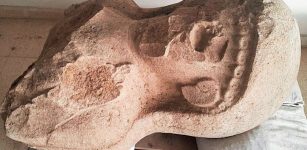 3,000-Year-Old Female Statue Unearthed In Turkey
Archaeology | Aug 11, 2017
3,000-Year-Old Female Statue Unearthed In Turkey
Archaeology | Aug 11, 2017 -
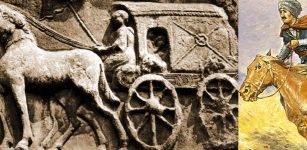 Struggle To Get Mail On Time Has Lasted More Than 5,000 Years – Part 1
Featured Stories | Jul 30, 2017
Struggle To Get Mail On Time Has Lasted More Than 5,000 Years – Part 1
Featured Stories | Jul 30, 2017 -
 Neanderthals Vanishing When Homo Sapiens Emerged In Europe Was Coincidental – Are Herbivores The Answer?
Evolution | Sep 29, 2023
Neanderthals Vanishing When Homo Sapiens Emerged In Europe Was Coincidental – Are Herbivores The Answer?
Evolution | Sep 29, 2023 -
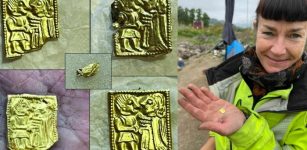 Mysterious Tiny 1,400-Year-Old Gold Foil Figures Found In Pagan Temple
Archaeology | Sep 23, 2023
Mysterious Tiny 1,400-Year-Old Gold Foil Figures Found In Pagan Temple
Archaeology | Sep 23, 2023 -
 Controversial Unexplained Ancient Mystery In Mongolia – Horrifying Sight – Part 2
Ancient Mysteries | May 2, 2018
Controversial Unexplained Ancient Mystery In Mongolia – Horrifying Sight – Part 2
Ancient Mysteries | May 2, 2018 -
 Remarkable Underground City Of Nushabad: A Masterpiece Of Ancient Architecture
Ancient Technology | Nov 17, 2015
Remarkable Underground City Of Nushabad: A Masterpiece Of Ancient Architecture
Ancient Technology | Nov 17, 2015 -
 Shieldmaiden Hervör’s Dangerous Quest For The Cursed Tyrfing Sword
Featured Stories | Apr 20, 2023
Shieldmaiden Hervör’s Dangerous Quest For The Cursed Tyrfing Sword
Featured Stories | Apr 20, 2023 -
 Similarities And Differences Between Living Spaces Of Neanderthals And Homo Sapiens
Archaeology | Apr 9, 2024
Similarities And Differences Between Living Spaces Of Neanderthals And Homo Sapiens
Archaeology | Apr 9, 2024 -
 Jomon Period: Triangle-Shaped Stone Artifact Depicting Human Face Found For The First Time In Japan
Archaeology | Dec 25, 2017
Jomon Period: Triangle-Shaped Stone Artifact Depicting Human Face Found For The First Time In Japan
Archaeology | Dec 25, 2017 -
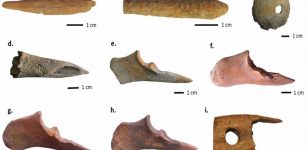 More Sophisticated Manufacturing In The Bronze Age – New Evidence
Archaeology | Jun 27, 2020
More Sophisticated Manufacturing In The Bronze Age – New Evidence
Archaeology | Jun 27, 2020 -
 ‘Saimaluu-Tash’ Time Capsule: Largest Millennia-Old Collection Of Petroglyphs In Central Asia
Civilizations | Nov 20, 2018
‘Saimaluu-Tash’ Time Capsule: Largest Millennia-Old Collection Of Petroglyphs In Central Asia
Civilizations | Nov 20, 2018 -
 Neanderthals Were Present In Italy Much Earlier Than Previously Thought
Archaeology | Nov 6, 2015
Neanderthals Were Present In Italy Much Earlier Than Previously Thought
Archaeology | Nov 6, 2015 -
 Second Gate Of Bazira And Unique Artifacts Discovered In The Ancient City Of Alexander The Great
Archaeology | Mar 29, 2022
Second Gate Of Bazira And Unique Artifacts Discovered In The Ancient City Of Alexander The Great
Archaeology | Mar 29, 2022

